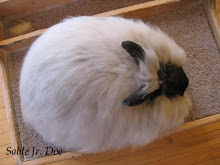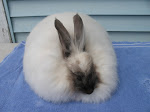
I finally got some pictures taken this week, and amazingly I also figured out how to upload them on this new computer, LOL! I have a monstrous amount of new rabbits in the barn now which is great, and thankfully I also have plenty of new FAs to add to the existing herd that was getting a little thinned out. Most of these shots below are of FAs, and there are actually many more juniors in the barn that I haven't photographed yet. I put together my best combinations for breeding this spring/summer and happily it resulted in some beautiful babies who will be filling the roster for upcoming show seasons (where the older buns leave off and retire to spend the rest of their careers in the nestbox:)).
I got lots of great Torts, which I guess is the one color that good rabbits here seem to be, but there were also some stunning REWs which was great because no color in angoras can truly compete with the wool of a white rabbit:). There are 4 more French litters coming up (all 8-9 weeks old now), but no one will be bred again til September to give the bucks a chance to recover from the heat of summer.
The first two babies pictured here are Giant crosses (F2's now). Both are nearly 9 weeks old and one is Chestnut while the other is REW. There were many other GA babies born this spring (probably too many, LOL), but most have either been Black or White except for two or three Chestnuts and one Steel. The Steel baby was surprising, but it showed me that my main GA sire SFF's Rubicon is Steel beneath the white, and I will have to work that out at some point. The Steel baby was too nice (and large:)) to get rid of, and her sire is an excellent buck with superb balance and wool quality, so I will keep them both and strip the steel out later using 'ee' animals. After this I will separate my lines to keep the gene contained while (hopefully) still managing to isolate the best qualities of the GA buck:).
CHESTNUT GA CROSS---9 WEEKS
This below is an older picture of one of Etienne's French babies at 10 wks. (Etienne usually produces my best show litters). This little girl is now almost 5 months old in Jr. prime. Her name will be Spang's Esperanza.

I thought these two pictures were very interesting because they show an F4 FA/NZ doe whose coat has changed dramatically in just over two years of life. Elenita had a perfectly textured coat when she was young, and her picture was even added to the latest Standard of Perfection. Several growth cycles later (and several litters later) she began to get much hairier. Now at approx. 2 years old, she has become so imbalanced that she is no longer fit to show. The darker color seen on the saddle area is a function of her abundant guard hair which contrasts sharply with the sides of her coat, which still have a correct ratio of guard hair to underwool. Elenita can no longer be shown, but since she has wonderful type, size, and production quality, she will stay on to breed for a much longer time. I don't worry much about her coat issue because even though an F4 generation rabbit is considered purebred, there is no question that the wool is still not 100% balanced on many of these animals, and another 2 generations are needed for them to become indistinguishable from 'genuine' purebreds.


This is a picture of Bijou last spring right before harvest (on a somewhat windy day). Her coat was slipping badly and it had become rough looking, dull, and disheveled. The picture at the very beginning of this post is Bijou again just yesterday, growing in her next new coat. She looks even, primed, and balanced again, and she should be stunning in another 2 months. The differences in coat quality for each growth phase become very apparent over time. A great wool judges can discern instantly what phase any angora is in, and some can even tell how long a rabbit has been in a particular phase (beginning, middle, end).

This here is Spang's Nikola, a Pearl doe in full coat last spring who recently weaned her first litter. I haven't looked these babies over yet, but I think there will be some nice ones in the bunch.

I thought these two pictures were very interesting because they show an F4 FA/NZ doe whose coat has changed dramatically in just over two years of life. Elenita had a perfectly textured coat when she was young, and her picture was even added to the latest Standard of Perfection. Several growth cycles later (and several litters later) she began to get much hairier. Now at approx. 2 years old, she has become so imbalanced that she is no longer fit to show. The darker color seen on the saddle area is a function of her abundant guard hair which contrasts sharply with the sides of her coat, which still have a correct ratio of guard hair to underwool. Elenita can no longer be shown, but since she has wonderful type, size, and production quality, she will stay on to breed for a much longer time. I don't worry much about her coat issue because even though an F4 generation rabbit is considered purebred, there is no question that the wool is still not 100% balanced on many of these animals, and another 2 generations are needed for them to become indistinguishable from 'genuine' purebreds.


This is a picture of Bijou last spring right before harvest (on a somewhat windy day). Her coat was slipping badly and it had become rough looking, dull, and disheveled. The picture at the very beginning of this post is Bijou again just yesterday, growing in her next new coat. She looks even, primed, and balanced again, and she should be stunning in another 2 months. The differences in coat quality for each growth phase become very apparent over time. A great wool judges can discern instantly what phase any angora is in, and some can even tell how long a rabbit has been in a particular phase (beginning, middle, end).

This here is Spang's Nikola, a Pearl doe in full coat last spring who recently weaned her first litter. I haven't looked these babies over yet, but I think there will be some nice ones in the bunch.




























1 comment:
My experience with Steels is that Chestnut cannot hide it, so just use your chestnut GAs to weed it out.
Post a Comment